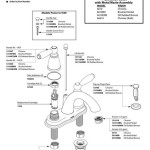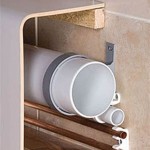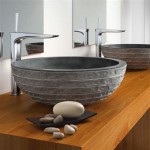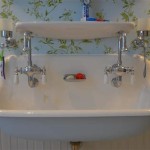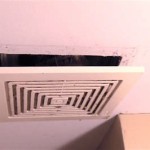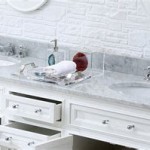Kitchen and Bathroom Sinks Won't Drain Water: Troubleshooting and Solutions
A clogged sink is a common household plumbing issue. Whether it's in the kitchen or the bathroom, a sink that won't drain water can be both inconvenient and unsanitary. Understanding the potential causes and knowing how to troubleshoot the problem is crucial for effective resolution. This article provides a comprehensive overview of the factors contributing to slow or stopped drainage in kitchen and bathroom sinks, along with detailed methods for diagnosing and rectifying these issues.
Identifying Common Causes of Drainage Problems
Several factors can contribute to a sink's inability to drain properly. These commonly include the accumulation of hair, soap scum, food debris, and mineral buildup within the drainpipe. Kitchen sinks are particularly susceptible to clogs due to grease and food particles washing down the drain. Bathroom sinks, on the other hand, often suffer from clogs caused by hair, soap residue, and toothpaste. Understanding the specific type of debris causing the blockage is the first step in selecting the appropriate solution.
In the kitchen, grease is a silent culprit. While it may flow down the drain as a liquid, it solidifies as it cools, adhering to the pipe walls and trapping other debris. Food particles, particularly starchy items like rice and pasta, can also expand and contribute to blockages. Coffee grounds are another common offender, as they tend to clump together and resist breaking down. In the bathroom, hair is a prime cause of clogs. Strands of hair can intertwine and collect soap scum, creating a dense, water-resistant mass. Soap, especially bar soap, contains fats that can solidify and accumulate over time, narrowing the drainpipe.
Beyond the typical debris, hard water can also contribute to drainage issues. Hard water contains high levels of minerals, such as calcium and magnesium, which can precipitate out of the water and form scale buildup on the inside of pipes. This scale reduces the diameter of the pipe, restricting water flow and eventually leading to a complete blockage. In older homes, pipe corrosion can also restrict water flow, further exacerbating drainage problems.
Step-by-Step Troubleshooting Guide
Before resorting to harsh chemicals or calling a plumber, a series of troubleshooting steps can be undertaken to identify and address the cause of the slow drain. These steps involve a systematic approach to examining the drain and its components.
1. Visual Inspection: Begin by visually inspecting the drain opening and the area immediately surrounding it. Check for any visible obstructions, such as clumps of hair or large food particles. Remove any visible debris using tweezers or gloved hands. A flashlight can be helpful for a better view into the drain opening. It is important to note the type and quantity of debris removed, as this can provide clues about the source of the blockage.
2. Plunger Application: A plunger is a simple yet effective tool for dislodging clogs. Ensure there is sufficient water in the sink to cover the cup of the plunger. Create a tight seal around the drain opening by pressing the plunger firmly against the sink. Plunge vigorously up and down for several minutes, maintaining the seal. Remove the plunger and check if the water drains. Repeat this process several times if necessary. It's important to use the correct type of plunger; a cup plunger is more suitable for flat surfaces like sinks, while a flange plunger is designed for toilets.
3. Check the Pop-up Stopper: Many bathroom sinks have a pop-up stopper mechanism that controls the drain opening. This mechanism can accumulate hair and debris, leading to clogs. Remove the stopper by lifting it out of the drain. Carefully clean any debris from the stopper and the surrounding area within the drain opening. Reinstall the stopper and test the drain. The pop-up stopper is typically connected to a lever system, which can also become clogged with debris. Inspecting and cleaning this lever system is essential for ensuring proper drain function.
4. Examine the P-Trap: The P-trap is a U-shaped section of pipe located under the sink. Its purpose is to trap debris and prevent sewer gases from entering the home. However, the P-trap itself can become clogged with accumulated debris. Place a bucket or container under the P-trap to catch any water. Loosen the slip nuts on both sides of the trap and carefully remove the trap. Clean out any debris inside the trap. Reassemble the trap, ensuring the slip nuts are securely tightened. Run water to test for leaks. When reassembling the P-trap, it's crucial to ensure that the gaskets are properly seated to prevent leaks; replacing the gaskets if they appear worn or damaged is recommended.
5. Use a Drain Snake: A drain snake, also known as an auger, is a flexible tool used to break up or retrieve clogs located deeper within the drainpipe. Insert the drain snake into the drain opening and carefully feed it down the pipe. Rotate the snake as it progresses, allowing it to break up or grab onto the clog. Once resistance is felt, continue rotating and maneuvering the snake to further loosen the clog. Slowly retract the snake, pulling out any debris. Run water to test the drain. The effectiveness of a drain snake depends on the type of clog. Solid, compact clogs are often easier to remove with a snake than greasy, sticky clogs, which may require chemical treatment or hydro-jetting.
Exploring Alternative Solutions
If the troubleshooting steps outlined above fail to resolve the drainage problem, alternative solutions can be considered. These solutions include the use of natural remedies and, as a last resort, chemical drain cleaners.
1. Hot Water Flush: Boiling water can sometimes dissolve minor clogs caused by grease or soap buildup. Carefully pour a pot of boiling water down the drain. Exercise caution when handling boiling water to avoid burns. This method is generally more effective for minor clogs in metal pipes; it is not recommended for PVC pipes, as the high temperature can potentially damage them. Repeat the process if necessary.
2. Baking Soda and Vinegar: A combination of baking soda and vinegar can create a natural drain cleaner. Pour one cup of baking soda down the drain, followed by one cup of vinegar. Allow the mixture to fizz and bubble for about 30 minutes. Then, flush the drain with hot water. The chemical reaction between baking soda and vinegar can help to break down grease and other organic matter. This method is generally safer than using harsh chemical drain cleaners and is often effective for minor clogs.
3. Enzyme Drain Cleaners: Enzyme drain cleaners contain enzymes that break down organic matter, such as food debris and hair. These cleaners are generally safer for pipes and the environment than chemical drain cleaners. Follow the instructions on the product label for application. Enzyme drain cleaners are most effective as a preventative measure. Regular use can help to prevent clogs from forming in the first place, especially in kitchen sinks that are prone to grease buildup.
4. Chemical Drain Cleaners (Use with Extreme Caution): Chemical drain cleaners should be used as a last resort, as they can be corrosive and damaging to pipes. Always wear protective gloves and eye protection when using chemical drain cleaners. Follow the instructions on the product label carefully. Never mix different types of drain cleaners, as this can create hazardous fumes. Chemical drain cleaners work by generating heat and dissolving the clog. However, they can also damage pipes, especially older pipes or PVC pipes. If the drain cleaner does not clear the clog, it is important to call a plumber. Allowing the chemical to sit in the pipes for an extended period can cause further damage.
Preventative Measures to Avoid Future Clogs
Preventing clogs is easier and more cost-effective than dealing with them after they occur. Implementing preventative measures can significantly reduce the likelihood of future drainage problems in both kitchen and bathroom sinks.
1. Strainers: Use strainers or mesh screens in the drain of both kitchen and bathroom sinks to catch hair, food particles, and other debris before they enter the drainpipe. Regularly clean the strainers to remove accumulated debris. Strainers are a simple and inexpensive way to prevent large particles from entering the drain system. Replacing the strainers when they become damaged or worn is important for maintaining their effectiveness.
2. Avoid Grease Down the Drain: Never pour cooking grease down the drain. Instead, allow grease to cool and solidify, then dispose of it in the trash. Wiping greasy pans with paper towels before washing them can also help to reduce the amount of grease that enters the drain. Even small amounts of grease can accumulate over time and contribute to significant clogs.
3. Regular Flushing: Periodically flush the drain with hot water to help prevent the buildup of grease and soap scum. Running hot water down the drain for several minutes each week can help to dissolve minor accumulations before they become major problems. Adding a small amount of dish soap to the hot water can also help to break down grease.
4. Periodic Cleaning: Regularly clean the P-trap and other accessible drain components to remove accumulated debris. This proactive approach can prevent clogs from forming and ensure proper drainage. Schedule regular cleaning sessions as part of a routine home maintenance plan.
5. Water Softener: If the home has hard water, consider installing a water softener to reduce mineral buildup in pipes. Water softeners remove calcium and magnesium from the water, reducing the formation of scale and extending the lifespan of plumbing fixtures and pipes. A water softener can be a significant investment, but it can prevent many plumbing problems. Proper maintenance of the water softener is key to its effectiveness.
By understanding the causes of drain clogs, following a systematic troubleshooting process, and implementing proactive preventative measures, homeowners can effectively address and minimize drainage problems in their kitchen and bathroom sinks. While DIY solutions can often resolve minor clogs, consulting a qualified plumber is recommended for persistent or complex drainage issues that require specialized tools and expertise. Ignoring significant blockages can lead to damage to the plumbing system and potential water damage within the home.

How To Fix A Bathroom Sink That Won T Drain Bfp Bay Area

How To Unclog A Slow Running Bathroom Sink Drain 10 Options

Unclogging A Sink 10 Dos And Don Ts Bob Vila

How To Unclog A Kitchen Sink Family Handyman

How You Can Fix A Slow Draining Drain On Your Own Call Ashton Plumbing

Why Is My Bathroom Basin Not Draining Living By Homeserve
How To Unclog A Sink 4 Easy Ways

6 Ways To Fix Clogged Drains Keep Pipes Flowing Freely Horizon Services

How To Clear A Clogged Drain Reviews By Wirecutter

How Often Should I Clean My Drains At Home
Related Posts

